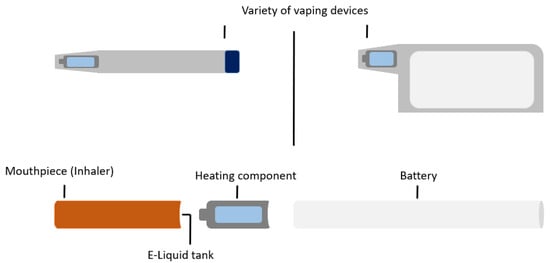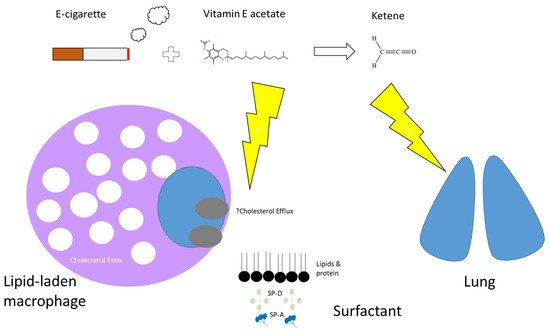You're using an outdated browser. Please upgrade to a modern browser for the best experience.
Please note this is a comparison between Version 1 by Marissa O'Callaghan and Version 2 by Lindsay Dong.
The lungs are exposed to a multitude of environmental agents with each inspiration. Some of these agents are toxic or cause damage to the lungs. Vaping or electronic cigarette (e-cigarette) use is no exception. These devices aerosolise a liquid vapour, which is then inhaled. This vapour contains chemical compounds such as nicotine, flavourings and tetrahydrocannabinol (THC). Some of these chemicals have irritative, toxic and carcinogenic properties. When inhaled these can alter the immune responses critical for normal lung function and cause lung injury. The pathological manifestation of this is diverse varying from organising pneumonia or diffuse alveolar damage to established interstitial lung disease (ILD).
- vaping
- e-cigarette
- foamy macrophages
1. Introduction
The damaging health consequences of cigarette smoking have been widely acknowledged for years [1][33]. While the ability to diagnose and the management of smoking-related diseases has improved considerably, cigarette smoking, unfortunately, remains prevalent, so health services remain inundated with smoking-related illnesses [2][3][34,35]. These include, but are not limited to, coronary artery disease, cerebrovascular disease, chronic obstructive pulmonary disease, lung cancer and respiratory tract infections [4][5][36,37].
Modern e-cigarettes, commercially developed in 2003, were advertised as a novel therapy for smoking cessation [6][11]. These electronic devices are designed to vaporise chemical compounds [7][45], the term ‘vaping’ referring to the perception that the exhaled smoke is water vapour. It actually consists of fine particles of chemicals mixed in vegetable glycerin (VG) and/or propylene glycol (PG) [8][46]. The vaping device consists of a mouthpiece, a battery, a tank which contains the “e-liquid” or “e-juice” and a heating component for the device (Figure 1) [7][9][45,47].

Figure 1.
E-cigarette or vaping device.
E-cigarettes have since been developed in various shapes, sizes and device types. Different terminologies used to describe these devices include e-cigs, vapes, e-hookahs, vape pens, mods, tanks or electronic nicotine delivery systems (ENDS) [7][45]. All delivery devices work on a similar principle. Electricity, activated manually or automatically by a battery, is delivered to the device’s heating component. This, in turn, causes the e-liquid contained in the tank to evaporate and condense into a fine mist of liquid droplets (aerosols) [10][48]. The e-liquid or substance placed in the device or tank is user-dependant. Commonly used substances include nicotine, fruity and menthol flavouring. A minority of users use e-liquids from unauthorised sources or modify the e-liquid contents. This risks exposure to potentially harmful compounds such as heavy metals or carcinogenic chemicals [7][11][45,49].
2. Epidemiology of E-Cigarette Use
E-Cigarettes are marketed as a harm reduction tool for tobacco smokers wishing to quit [6][11]. They are advertised as a safe and viable alternative to cigarette smoking; however, there is a lack of evidence to prove superiority to conventional smoking cessation strategies [7][12][45,50]. E-cigarette use worldwide has grown dramatically, with a prevalence of 5.5% amongst adults in both North America and England [6][13][14][15][11,51,52,53]. The response from tobacco regulatory officials has been mixed. Some are promoting the use of e-cigarettes for harm minimisation [16][10], while others have requested regulation of the nicotine market, favouring proven smoking cessation techniques. Data to support any of these marketing strategies remain limited. E-Cigarette users are varied and include people who have never smoked, ex-smokers who have switched to e-cigarettes and dual-users of both conventional cigarettes and e-cigarettes [6][11]. The role of e-cigarettes as a smoking cessation tool is hotly contested. Trial results have been mixed and ultimately inconclusive. E-cigarettes with nicotine likely increase smoking cessation rates compared to e-cigarettes without nicotine. In addition, there is no clear evidence of harm from nicotine e-cigarettes; however, the patient numbers in the studies to date have been low, and the longest follow-up period was two years [17][18][54,55]. E-cigarettes with nicotine demonstrated improved smoking cessation rates over conventional nicotine replacement therapy in a recently published randomised control trial. The caveat in this study was that participants in both groups had regular face-to-face meetings with clinicians, a form of support that is rarely provided to those seeking to quit in the real world [19][56]. Furthermore, only 18% of participants in the e-cigarette group stopped smoking entirely, suggesting that e-cigarettes are a far cry from a “cure” for tobacco smoking. Some studies even suggest that there are increased smoking relapse rates when e-cigarettes are used as a cessation tool [20][21][57,58]. Major tobacco companies entered the e-cigarette industry in 2012 and have since progressively dominated the market, buying out smaller retailers [22][23][65,66]. These companies are more likely to sell ‘cigalikes’, a form of e-cigarette with a slim cylindrical closed-system design that uses prefilled cartridges, to maximise the ease of use. These devices mimic the experience of smoking conventional cigarettes and studies suggest that smokers of cigalikes are more likely to remain dual users [23][24][25][66,67,68]. While other factors may also be contributory, international surveys show that one out of eight smokers have tried e-cigarettes, with the highest prevalence being amongst younger, female, higher-income smokers [26][27][69,70]. E-cigarette users view e-cigarettes as safer, healthier and less likely to cause dependency than conventional cigarettes [3][26][27][28][29][30][31][35,69,70,71,72,73,74]. However, without clear evidence of a role in the reduction of tobacco dependence, e-cigarettes risk renormalising and re-glamorising smoking. This is of paramount concern, potentially undoing years of effort by the public health and medical communities [3][32][35,75].3. Mechanism of Injury with Vaping
While analysis of e-cigarette efficacy in aiding smoking cessation is ongoing, data on the overall impact of e-cigarettes on population health is limited [3][35]. Over 7000 compounds and at least 70 carcinogens have been identified in conventional tobacco smoke [1][3][33][34][35][33,35,76,77,78]. Studies comparing the toxic exposures between e-cigarettes and conventional cigarettes reported that levels of two nitrosamines and carbon monoxide were lower in e-cigarette users than in smokers but present nonetheless [36][37][38][39][1,2,3,4]. Unsurprisingly, toxic exposures were greatest in dual users [35][78]. Both smokers and e-cigarette users also had increased toxic metals in urine and blood, but there was some variability in the metals detected in each group [6][35][36][39][1,4,11,78]. While there are greater chemical emissions from combustible tobacco cigarette smoke than from most e-cigarette products, the chemicals in e-liquids and the additional chemicals generated during the aerosolisation of e-liquids also have potential toxic properties [40][41][42][80,81,82]. It has been proposed that oxidative stress is the primary driver of e-cigarette-induced toxicity at a cellular level [6][40][43][44][45][46][47][48][49][50][11,80,83,84,85,86,87,88,89,90]. While this theory is a plausible explanation for the tissue injuries reported in the literature, the impact is less than that caused by combustible tobacco smoking [51][91]. Another group demonstrated acute endothelial cell dysfunction following e-cigarette aerosol exposure but highlights the uncertainty surrounding the long-term consequences and outcomes with long term exposure [40][52][80,92]. Scott et al. sought to replicate the potential effects of exposure of the e-cigarette user in an acute in vitro system using a vaping-condensate technique. They showed that exposure of macrophages to e-cigarette vapour-condensate induced many of the same cellular and functional changes in alveolar macrophages seen in cigarette smokers and patients with COPD [43][83]. Adolescents who use e-cigarettes commonly report an increased cough and wheeze, and studies have shown an association with e-cigarette use and asthma exacerbations [2][53][54][34,93,94]. However, it is not yet clear if chronic e-cigarette use by itself can cause COPD in a clinical setting or if the substitution of e-cigarettes for combustible tobacco products can prevent or slow the development of COPD [40][55][56][80,95,96]. There is also data to support a correlation between e-cigarette use and impaired host defence [57][58][97,98]. It appears viral responses are compromised [46][86], and bacterial clearance by macrophages [43][59][83,99] and neutrophils appears to be reduced [60][61][100,101]. This allows increased adhesion and colonisation of bacteria [60][62][100,102] and possibly an impaired infection-fighting ability [3][35].4. Electronic Cigarette and Vaping-Associated Lung Injury
A wide range of clinical presentations have been reported in the literature [63][64][65][66][67][68][69][70][71][7,8,9,13,15,21,22,23,28]. Respiratory symptoms are the most prevalent at hospital presentation, specifically dyspnoea, cough and chest pain. Many patients report associated gastrointestinal symptoms and constitutional symptoms, most commonly subjective fever [65][66][9,13] (Table 1). Laboratory testing frequently reveals a peripheral blood eosinophilia, elevated erythrocyte sedimentation rate (ESR) and the presence of lipid-laden macrophages on bronchoalveolar lavage (BAL) assessment [68][70][72][21,23,109]. Most patients will have abnormal chest imaging. Typical computed tomography (CT) thorax findings are bilateral lung opacities with ground-glass changes, sometimes with subpleural sparing (Figure 2). Other reported findings include pneumomediastinum, pleural effusion and pneumothorax [65][9].
Figure 2. Images show electronic cigarette or vaping product use–associated lung injury in an 18-year-old male who attended our institution. Axial CT chest imaging (A–C) demonstrates extensive bilateral centrilobular and peri-bronchial ground glass opacification with subpleural sparing, slightly more confluent in the lower zones.
Although the exact mechanism of lung injury remains unclear and under investigation, exposure to products containing tetrahydrocannabinol (THC) was reported in over 80% of cases [73][110], and in many cases, unregulated or illicit street sources of THC were reported [74][75][111,112]. THC is the main psychoactive component in cannabis and despite THC-based oils and waxes being illegal in most American States, they remain easily accessible. THC-containing products that were seized by United States law enforcement at the peak of the EVALI outbreak, contained higher levels of vitamin E acetate than would be expected [65][76][9,113]. Furthermore, BAL samples from patients with EVALI have shown high rates of vitamin E [77][114] with a notable absence of vitamin E acetate in samples obtained from a healthy comparison group [78][115]. Vitamin E is a naturally occurring compound in surfactant, however, in contrast, vitamin E acetate is the synthetic ester of tocopherol and acetate. It is commonly added to e-liquids as a thickening agent [78][115].
The mechanism by which vitamin E acetate causes lung injury is not fully understood. Mice exposed to aerosols generated from vitamin E acetate have demonstrated elevated levels of BAL lipid-laden macrophages on Oil-Red-O stain [79][116], which is in keeping with the BAL findings in patients with EVALI [68][72][21,109] (Figure 3). The presence of lipid-laden macrophages led to studies looking at macrophage lipid metabolism. It is possible that increasing concentrations of vitamin E or vitamin E acetate could affect the physical structure and phase behaviour of surfactants [78][80][115,117]. This may then impair the ability of the surfactants to maintain alveolar surface tension, leading to respiratory dysfunction [71][78][79][28,115,116]. Furthermore, vitamin E acetate forms a toxic compound, ketene, when heated. Ketene is a known lung irritant and thus may also contribute to the chemical pneumonitis seen in patients with EVALI [78][81][82][115,118,119] (Figure 4).




Figure 3. (A,B) Bronchoalveolar lavage (BAL) cytology from a patient diagnosed with EVALI in our institution, stained with Oil-Red-O × 400 magnification showing positive red intracytoplasmic droplets in the alveolar macrophages, consistent with excess neutral lipid.


Figure 4. Proposed mechanism of action by which e-cigarettes cause lung injury. Many e-cigarettes that contain tetrahydrocannabinol (THC) have been shown to have higher levels of vitamin E acetate, commonly used as a thickening agent. It is possible that increased exposure of the lungs to Vitamin E (naturally occurring at low levels in surfactant) or Vitamin E acetate could affect the physical structure and phase behaviour of surfactant, impairing its ability to maintain surface tension leading to respiratory distress. Dysfunctional surfactant might lead to excess lipid accumulation within alveolar macrophages and that reverse cholesterol transport or cholesterol efflux might be implicated. Secondly, a known product of vaporised vitamin E acetate is ketene which is believed to be a lung irritant.
While most patients with EVALI went on to have a full recovery, over 2800 patients were hospitalised, and 68 deaths were reported throughout the outbreak [83][120]. Many case reports describe improvement with corticosteroid therapy [67][15]; however, the natural progression of this injury is not yet known, and it is possible that patients might recover without steroids or by avoiding use of e-cigarettes alone [67][15]. Nevertheless, because the diagnosis remains one of exclusion, empiric antimicrobial therapy might be warranted for patients with severe illness [65][84][9,121].
